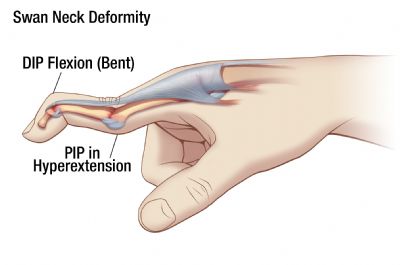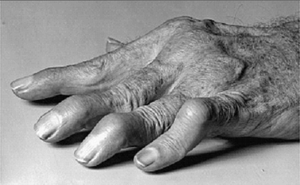Swan-Neck Deformity: Difference between revisions
No edit summary |
No edit summary |
||
| Line 7: | Line 7: | ||
<div class="noeditbox"> ==Page Under Review== This article is currently under review and may not be up to date. Please come back soon to see the finished work! 13 October 2020 </div> | <div class="noeditbox"> ==Page Under Review== This article is currently under review and may not be up to date. Please come back soon to see the finished work! 13 October 2020 </div> | ||
== | == <u>Definition/Description</u> == | ||
Swan-Neck Deformity (SND) is a deformity of the finger | [[File:Swan-neck deformity.jpg|thumb|400x400px]] | ||
Swan-Neck Deformity (SND) is a deformity of the finger characterized by hyperextension of the proximal interphalangeal joint (PIP) and flexion of the distal interphalangeal joint (DIP). Reciprocal flexion of the metacarpal phalangeal joint (MCP) can also be present. A Swan-Neck Deformity is caused by an imbalance to the extensor mechanism of the digit. The deformity develops when there is a loss of extension at the distal phalanx or tightening of the extensor mechanism at the proximal phalanx. <ref name=":5">Lane R, Nallamothu SV. [https://www.ncbi.nlm.nih.gov/books/NBK525970/ Swan-Neck Deformity]. InStatPearls [Internet] 2019 Feb 4. StatPearls Publishing.</ref> | |||
== | == <u>Etiology/Epidemiology</u> == | ||
Swan-Neck Deformity is initially caused by damage to the attachment of the extensor tendon.<ref name=":0">MedicalNewsToday. What's to know about swan neck deformity. Available from: <nowiki>https://www.medicalnewstoday.com/articles/318642.php</nowiki> (accessed 15 February 2019)</ref> Injury to the extensor tendon can be caused by a traumatic laceration, a closed avulsion from a direct blow to the DIP while digit is extended, or by weakening at the DIP from chronic inflammation as well as extensor tendon subluxation due to an inflammatory disease most commonly rheumatoid arthritis.<ref name=":5" /> | |||
== Treatment == | Damage to the extensor mechanism results in laxity at the volar plate and tightness at the triangular ligament around the proximal interphalangeal (PIP). <ref name=":5" /> The resulting shape looks similar to a swan’s neck, which is how the condition got its name.<ref name=":0" /> | ||
Swan-Neck Deformity can be caused by a variety of conditions such as [[Rheumatoid Arthritis|rheumatoid arthritis]]<ref name=":3">Brulard C, Sauvage A, Mares O, Wavreille G, Fontaine C. Treatment of rheumatoid swan neck deformity by tenodesis of proximal interphalangeal joint with a half flexor digitorum superficialis tendon. About 23 fingers at 61 months follow-up. Chirurgie de la main. 2012 Jun;31(3):118-27.</ref><ref>Chinchalkar SJ, Lanting BA, Ross D. Swan neck deformity after distal interphalangeal joint flexion contractures: a biomechanical analysis. Journal of Hand Therapy. 2010 Oct 1;23(4):420-5.</ref>, untreated [[Mallet Finger|mallet finger]], various disorders such as [[Cerebral Palsy Introduction|cerebral palsy]]<ref name=":4">Carlson EJ, Carlson MG. Treatment of swan neck deformity in cerebral palsy. The Journal of hand surgery. 2014 Apr 1;39(4):768-72.</ref>, [[stroke]], [[Parkinson's|Parkinson’s disease]], traumatic brain injury, [[Psoriatic Arthritis|psoriatic arthritis]], [[scleroderma]] and hand trauma.<ref name=":5" /> | |||
== <u>Characteristics/Clinical Presentation</u> == | |||
Symptoms include inflammation of the joints, stiffness in the fingers, and a gradual difficulty in bending the middle joint because of the location of the tendons. A snapping sensation can happen during bending.<ref name=":2">ASSH. Swan Neck Deformity. Available from: <nowiki>http://www.assh.org/handcare/hand-arm-conditions/swan-neck-deformity</nowiki> (accessed 15 February 2019)</ref> | |||
== <u>Evaluation</u> == | |||
== <u>Treatment</u> == | |||
There are many treatments available for this deformity, depending on the condition’s severity.There are two categories of treatment: surgical and nonsurgical. | There are many treatments available for this deformity, depending on the condition’s severity.There are two categories of treatment: surgical and nonsurgical. | ||
===Non-Surgical === | ===='''Non-Surgical''' ==== | ||
Hand therapy for passive stretching combined with corrective splinting may benefit even chronic conditions.This combination of treatment may increase mobility and flexibility at both the DIP and the PIP joints.Extension block splints may help correct the hyperextension at the PIP joint.Progressive extension splinting can help improve the DIP flexion deformity.Although stretching and splinting may increase mobility,severe or long-standing deformities will not likely achieve true correction without surgery<ref name=":1" />. | Hand therapy for passive stretching combined with corrective splinting may benefit even chronic conditions.This combination of treatment may increase mobility and flexibility at both the DIP and the PIP joints.Extension block splints may help correct the hyperextension at the PIP joint.Progressive extension splinting can help improve the DIP flexion deformity.Although stretching and splinting may increase mobility,severe or long-standing deformities will not likely achieve true correction without surgery<ref name=":1">Lane R, Nallamothu SV. Swan-Neck Deformity. InStatPearls [Internet] 2018 Sep 10. StatPearls Publishing.</ref>. | ||
===Surgical=== | ===='''Surgical'''==== | ||
Surgical treatments are many and varied.They mainly involve the prevention of the abnormal middle joint extension.Some involve repositioning of the tendons on the side of the middle joint.If the middle joint is stiff or arthritic,the joint may be replaced or fused in a slightly bent position<ref name=":2" /><ref name=":4" /><ref name=":3" />. | Surgical treatments are many and varied.They mainly involve the prevention of the abnormal middle joint extension.Some involve repositioning of the tendons on the side of the middle joint.If the middle joint is stiff or arthritic,the joint may be replaced or fused in a slightly bent position<ref name=":2" /><ref name=":4" /><ref name=":3" />. | ||
===Postoperative and Rehabilitation Care=== | ===='''Postoperative and Rehabilitation Care'''==== | ||
The hand should be immobilised in a plaster splint with the MCP joints in full extension and PIP joints flexed.Active flexion exercises should begin within the first 4 to5 days if '''flexor tenosynovectomy''' has been performed. Dorsal extension blocking should be placed until 4 to 6 weeks postoperatively<ref name=":1" />. | The hand should be immobilised in a plaster splint with the MCP joints in full extension and PIP joints flexed.Active flexion exercises should begin within the first 4 to5 days if '''flexor tenosynovectomy''' has been performed. Dorsal extension blocking should be placed until 4 to 6 weeks postoperatively<ref name=":1" />. | ||
This video details how to use an Oval-8 Finger Splint for Swan Neck Deformity injuries. | This video details how to use an Oval-8 Finger Splint for Swan Neck Deformity injuries. | ||
{{#ev: youtube | Dv_fTqEeFGQ}}<ref>3 Point Products. How to Treat Swan Neck Deformity with an Oval-8 Finger Splint. Available from: https://youtu.be/Dv_fTqEeFGQ</ref> | {{#ev: youtube | Dv_fTqEeFGQ}}<ref>3 Point Products. How to Treat Swan Neck Deformity with an Oval-8 Finger Splint. Available from: https://youtu.be/Dv_fTqEeFGQ</ref> | ||
== <u>Differential Diagnosis</u> == | |||
[[File:SWAN NECK SS.png|thumb]] | |||
The [[Boutonniere Deformity|boutonniere deformity]] can be mistaken for a swan-neck deformity. It is important to recognize that [[Boutonniere Deformity|boutonniere deformity]] consists of hyperextension of the DIP and flexion of the PIP.<ref>McKeon KE, Lee DH. Posttraumatic boutonniere and swan neck deformities. JAAOS-Journal of the American Academy of Orthopaedic Surgeons. 2015 Oct 1;23(10):623-32.</ref> | |||
== References == | == References == | ||
Revision as of 19:05, 15 October 2020
Original Editor - Boaz Telfort
Top Contributors - Shaimaa Eldib, Beverly Klinger, Boaz Telfort, Kim Jackson, Chrysolite Jyothi Kommu, Nikhil Benhur Abburi, Wanda van Niekerk and Anas Mohamed
Definition/Description[edit | edit source]
Swan-Neck Deformity (SND) is a deformity of the finger characterized by hyperextension of the proximal interphalangeal joint (PIP) and flexion of the distal interphalangeal joint (DIP). Reciprocal flexion of the metacarpal phalangeal joint (MCP) can also be present. A Swan-Neck Deformity is caused by an imbalance to the extensor mechanism of the digit. The deformity develops when there is a loss of extension at the distal phalanx or tightening of the extensor mechanism at the proximal phalanx. [1]
Etiology/Epidemiology[edit | edit source]
Swan-Neck Deformity is initially caused by damage to the attachment of the extensor tendon.[2] Injury to the extensor tendon can be caused by a traumatic laceration, a closed avulsion from a direct blow to the DIP while digit is extended, or by weakening at the DIP from chronic inflammation as well as extensor tendon subluxation due to an inflammatory disease most commonly rheumatoid arthritis.[1]
Damage to the extensor mechanism results in laxity at the volar plate and tightness at the triangular ligament around the proximal interphalangeal (PIP). [1] The resulting shape looks similar to a swan’s neck, which is how the condition got its name.[2]
Swan-Neck Deformity can be caused by a variety of conditions such as rheumatoid arthritis[3][4], untreated mallet finger, various disorders such as cerebral palsy[5], stroke, Parkinson’s disease, traumatic brain injury, psoriatic arthritis, scleroderma and hand trauma.[1]
Characteristics/Clinical Presentation[edit | edit source]
Symptoms include inflammation of the joints, stiffness in the fingers, and a gradual difficulty in bending the middle joint because of the location of the tendons. A snapping sensation can happen during bending.[6]
Evaluation[edit | edit source]
Treatment[edit | edit source]
There are many treatments available for this deformity, depending on the condition’s severity.There are two categories of treatment: surgical and nonsurgical.
Non-Surgical[edit | edit source]
Hand therapy for passive stretching combined with corrective splinting may benefit even chronic conditions.This combination of treatment may increase mobility and flexibility at both the DIP and the PIP joints.Extension block splints may help correct the hyperextension at the PIP joint.Progressive extension splinting can help improve the DIP flexion deformity.Although stretching and splinting may increase mobility,severe or long-standing deformities will not likely achieve true correction without surgery[7].
Surgical[edit | edit source]
Surgical treatments are many and varied.They mainly involve the prevention of the abnormal middle joint extension.Some involve repositioning of the tendons on the side of the middle joint.If the middle joint is stiff or arthritic,the joint may be replaced or fused in a slightly bent position[6][5][3].
Postoperative and Rehabilitation Care[edit | edit source]
The hand should be immobilised in a plaster splint with the MCP joints in full extension and PIP joints flexed.Active flexion exercises should begin within the first 4 to5 days if flexor tenosynovectomy has been performed. Dorsal extension blocking should be placed until 4 to 6 weeks postoperatively[7].
This video details how to use an Oval-8 Finger Splint for Swan Neck Deformity injuries.
Differential Diagnosis[edit | edit source]
The boutonniere deformity can be mistaken for a swan-neck deformity. It is important to recognize that boutonniere deformity consists of hyperextension of the DIP and flexion of the PIP.[9]
References[edit | edit source]
- ↑ 1.0 1.1 1.2 1.3 Lane R, Nallamothu SV. Swan-Neck Deformity. InStatPearls [Internet] 2019 Feb 4. StatPearls Publishing.
- ↑ 2.0 2.1 MedicalNewsToday. What's to know about swan neck deformity. Available from: https://www.medicalnewstoday.com/articles/318642.php (accessed 15 February 2019)
- ↑ 3.0 3.1 Brulard C, Sauvage A, Mares O, Wavreille G, Fontaine C. Treatment of rheumatoid swan neck deformity by tenodesis of proximal interphalangeal joint with a half flexor digitorum superficialis tendon. About 23 fingers at 61 months follow-up. Chirurgie de la main. 2012 Jun;31(3):118-27.
- ↑ Chinchalkar SJ, Lanting BA, Ross D. Swan neck deformity after distal interphalangeal joint flexion contractures: a biomechanical analysis. Journal of Hand Therapy. 2010 Oct 1;23(4):420-5.
- ↑ 5.0 5.1 Carlson EJ, Carlson MG. Treatment of swan neck deformity in cerebral palsy. The Journal of hand surgery. 2014 Apr 1;39(4):768-72.
- ↑ 6.0 6.1 ASSH. Swan Neck Deformity. Available from: http://www.assh.org/handcare/hand-arm-conditions/swan-neck-deformity (accessed 15 February 2019)
- ↑ 7.0 7.1 Lane R, Nallamothu SV. Swan-Neck Deformity. InStatPearls [Internet] 2018 Sep 10. StatPearls Publishing.
- ↑ 3 Point Products. How to Treat Swan Neck Deformity with an Oval-8 Finger Splint. Available from: https://youtu.be/Dv_fTqEeFGQ
- ↑ McKeon KE, Lee DH. Posttraumatic boutonniere and swan neck deformities. JAAOS-Journal of the American Academy of Orthopaedic Surgeons. 2015 Oct 1;23(10):623-32.








